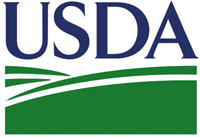 USDA’s new planted acreage report out Wednesday morning estimates corn acreage planted is two percent higher than last year, but that is down a point from the March report with more acres are going to soybeans. Corn planted area for all purposes in 2010 is estimated at 87.9 million acres, up 2 percent from last year. Acreage is up in Illinois, Kansas, Indiana, Missouri and Ohio; but down significantly in Iowa, Nebraska and South Dakota. Soybean planted area for 2010 is estimated at a record high 78.9 million acres, up 2 percent from last year.
USDA’s new planted acreage report out Wednesday morning estimates corn acreage planted is two percent higher than last year, but that is down a point from the March report with more acres are going to soybeans. Corn planted area for all purposes in 2010 is estimated at 87.9 million acres, up 2 percent from last year. Acreage is up in Illinois, Kansas, Indiana, Missouri and Ohio; but down significantly in Iowa, Nebraska and South Dakota. Soybean planted area for 2010 is estimated at a record high 78.9 million acres, up 2 percent from last year.
Actually, the total amount of land dedicated to crops in the United States has dropped for the second straight year in 2010, according to the report, which shows total cropland has declined 6 million acres since 2008. The Renewable Fuels Association (RFA) notes that this is further evidence growth in ethanol production is not leading to cropland expansion.
 “The data clearly show that crop acres in the United States continue to trend downward,” said Bob Dinneen, RFA president and CEO. “That’s because new technology and dramatically increasing yields are allowing farmers to produce more crops on less land. Today’s report reinforces the fact that the nation’s farmers simply don’t need to expand cropland to meet global demands for food, feed, fiber, and biofuels.”
“The data clearly show that crop acres in the United States continue to trend downward,” said Bob Dinneen, RFA president and CEO. “That’s because new technology and dramatically increasing yields are allowing farmers to produce more crops on less land. Today’s report reinforces the fact that the nation’s farmers simply don’t need to expand cropland to meet global demands for food, feed, fiber, and biofuels.”
While corn acres are up compared to last year, that increase is more than offset by reductions in acreage for other coarse grains and wheat. USDA estimates total 2010 crop acres at 318.9 million, down from 319.3 million in 2009 and 325 million in 2008. For the sake of comparison, RFA noted that total planted acres averaged 327 million during the decade of the 1990s. A record corn crop of at least 13.3 billion bushels is expected in 2010, despite the fact that farmers planted nearly 6 million less acres of corn than in 2007 when the first 13 billion bushel crop was achieved.
RFA also noted that corn plantings were down from last year in many states with high levels of Conservation Reserve Program (CRP) acreage, which challenges the notion that grain ethanol expansion is leading to increased CRP conversion. For instance, corn acres dropped 4% in Texas, the leading CRP state in the nation. Corn acres also fell 7% in South Dakota, 4% in Nebraska, 3% in Iowa, and 1.3% in Minnesota.

